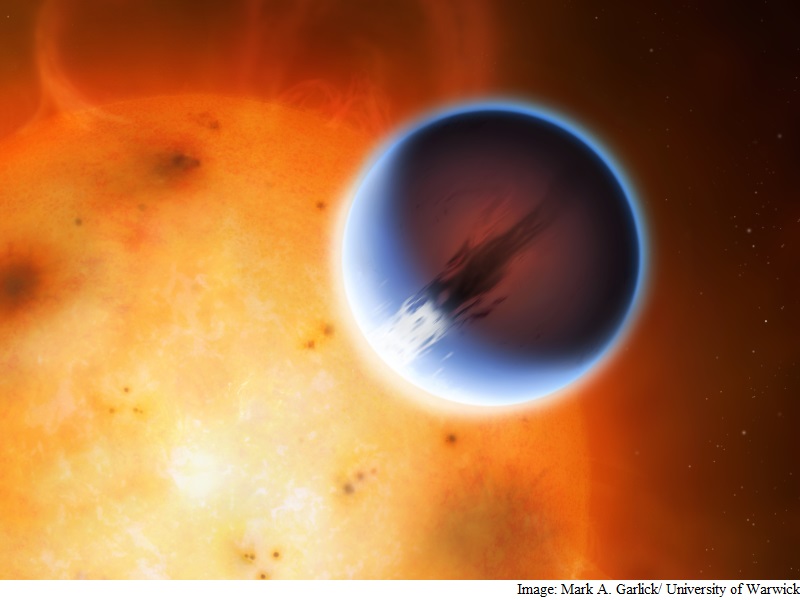- Home
- Science
- Science News
- Astronomers Measure Wind Speeds of 8,690Kmph on Exoplanet
Astronomers Measure Wind Speeds of 8,690Kmph on Exoplanet

An exoplanet located about 63 light-years away has winds reaching a staggering 8,690kmph, around 20 times faster than ever recorded on Earth, according to the first ever weather map of a planet outside our solar system.
The finding by researchers at University of Warwick in the UK is the first time that a weather system on a planet outside of Earth's solar system has been directly measured and mapped.
The wind speed recorded is 20 times greater than the fastest ever known on Earth, where it would be seven times the speed of sound, researchers said.
"This is the first ever weather map from outside of our solar system. Whilst we have previously known of wind on exoplanets, we have never before been able to directly measure and map a weather system," said lead researcher Tom Louden, of the University of Warwick's Astrophysics group.
Discovered on the exoplanet HD 189733b, researchers measured the velocities on the two sides of HD 189733b and found a strong wind moving at over 8,690kmph blowing from its day-side to its night side.
"HD 189733b's velocity was measured using high resolution spectroscopy of the Sodium absorption featured in its atmosphere," said Louden.
Researchers said the techniques used could help the study of Earth-like planets.
"We are tremendously excited to have found a way to map weather systems on distant planets," said co-researcher, Dr. Peter Wheatley of the University of Warwick's Astrophysics Group.
"As we develop the technique further we will be able to study wind flows in increasing detail and make weather maps of smaller planets. Ultimately this technique will allow us to image the weather systems on Earth-like planets," said Wheatley.
HD 189733b is one of the most studied of a class of planets known as 'Hot Jupiters'.
At over 10 percent larger than Jupiter, but 180 times closer to its star, HD 189733b has a temperature of 1,200-degrees Celsius.
Its size and relatively closeness to our solar system make it a popular target for astronomers. Past research has shown that the day side of the planet would appear a bright shade of blue to the human eye, probably due to clouds of silicate particles high in its atmosphere.
The data was collected by HARPS, the High Accuracy Radial velocity Planet Searcher, in La Silla, Chile.
The research was published in the Astrophysical Journal Letters.
Get your daily dose of tech news, reviews, and insights, in under 80 characters on Gadgets 360 Turbo. Connect with fellow tech lovers on our Forum. Follow us on X, Facebook, WhatsApp, Threads and Google News for instant updates. Catch all the action on our YouTube channel.
Related Stories
- Samsung Galaxy Unpacked 2025
- ChatGPT
- Redmi Note 14 Pro+
- iPhone 16
- Apple Vision Pro
- Oneplus 12
- OnePlus Nord CE 3 Lite 5G
- iPhone 13
- Xiaomi 14 Pro
- Oppo Find N3
- Tecno Spark Go (2023)
- Realme V30
- Best Phones Under 25000
- Samsung Galaxy S24 Series
- Cryptocurrency
- iQoo 12
- Samsung Galaxy S24 Ultra
- Giottus
- Samsung Galaxy Z Flip 5
- Apple 'Scary Fast'
- Housefull 5
- GoPro Hero 12 Black Review
- Invincible Season 2
- JioGlass
- HD Ready TV
- Laptop Under 50000
- Smartwatch Under 10000
- Latest Mobile Phones
- Compare Phones
- Honor Win RT
- Honor Win
- Xiaomi 17 Ultra Leica Edition
- Xiaomi 17 Ultra
- Huawei Nova 15
- Huawei Nova 15 Pro
- Huawei Nova 15 Ultra
- OnePlus 15R
- Asus ProArt P16
- MacBook Pro 14-inch (M5, 2025)
- OPPO Pad Air 5
- Huawei MatePad 11.5 (2026)
- Xiaomi Watch 5
- Huawei Watch 10th Anniversary Edition
- Acerpure Nitro Z Series 100-inch QLED TV
- Samsung 43 Inch LED Ultra HD (4K) Smart TV (UA43UE81AFULXL)
- Asus ROG Ally
- Nintendo Switch Lite
- Haier 1.6 Ton 5 Star Inverter Split AC (HSU19G-MZAID5BN-INV)
- Haier 1.6 Ton 5 Star Inverter Split AC (HSU19G-MZAIM5BN-INV)

















